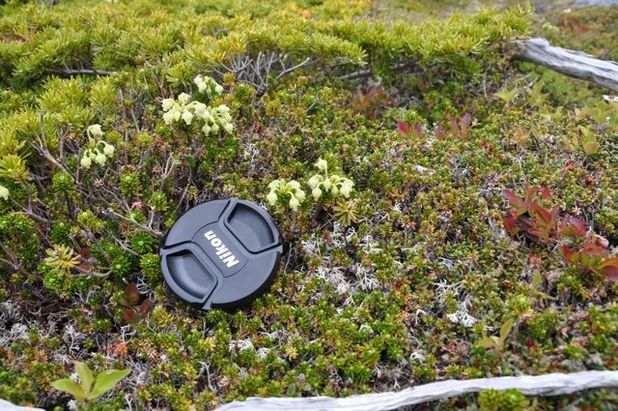Yellow mountain-heather, yellow mountainheath •
Phyllodoce glanduliflora
Identification
Yellow mountain-heather is a low-growing shrub, with branching stems from 10-40 cm tall. The alternating evergreen leaves are small and needle-like, up to 1 cm long. The edges of the leaves have tiny glands, and the undersides of the leaves are grooved. The yellow flowers are the distinguishing feature of yellow mountain-heather; they are pale yellow to greenish, urn-shaped, and small at less than 1 cm. Both the flowers and their stalks are sticky and hairy. They may be in clusters of a few to many.
Habitat & Range
Usually found at high elevations, yellow mountain-heather is found throughout BC, north to Alaska and the Yukon and Northwest Territories, east to parts of Alberta, and south to Oregon and Wyoming.
This species is found in various moisture regimes, in open woodlands, meadows, and subalpine to alpine heath.
Similar Species
Many species of mountain-heather may grow in close proximity and are very similar, including Alaskan mountain-heather and pink mountain-heather. These species can be very hard to tell apart when not in flower.
The other two species have more bell-shaped flowers that are open at the end, in contrast to the urn-shaped flowers of yellow mountain-heather, which come back together at the tips. Alaskan mountain-heather has leaves that are rounded on the underside, rather than grooved. To make matters more complicated, pink and yellow mountain-heather can sometimes hybridize and form a species termed Phyllodoce intermedia.
Another species that is quite similar is white mountain-heather. It's leaves are more scale-like, however, which sets it apart.
Crowberry also looks quite similar to the mountain-heathers, but it has very small and inconspicuous flowers and smaller, shorter leaves.
Yellow mountain-heather is a low-growing shrub, with branching stems from 10-40 cm tall. The alternating evergreen leaves are small and needle-like, up to 1 cm long. The edges of the leaves have tiny glands, and the undersides of the leaves are grooved. The yellow flowers are the distinguishing feature of yellow mountain-heather; they are pale yellow to greenish, urn-shaped, and small at less than 1 cm. Both the flowers and their stalks are sticky and hairy. They may be in clusters of a few to many.
Habitat & Range
Usually found at high elevations, yellow mountain-heather is found throughout BC, north to Alaska and the Yukon and Northwest Territories, east to parts of Alberta, and south to Oregon and Wyoming.
This species is found in various moisture regimes, in open woodlands, meadows, and subalpine to alpine heath.
Similar Species
Many species of mountain-heather may grow in close proximity and are very similar, including Alaskan mountain-heather and pink mountain-heather. These species can be very hard to tell apart when not in flower.
The other two species have more bell-shaped flowers that are open at the end, in contrast to the urn-shaped flowers of yellow mountain-heather, which come back together at the tips. Alaskan mountain-heather has leaves that are rounded on the underside, rather than grooved. To make matters more complicated, pink and yellow mountain-heather can sometimes hybridize and form a species termed Phyllodoce intermedia.
Another species that is quite similar is white mountain-heather. It's leaves are more scale-like, however, which sets it apart.
Crowberry also looks quite similar to the mountain-heathers, but it has very small and inconspicuous flowers and smaller, shorter leaves.
References
Pojar, J. and MacKinnon, A. (2005). Plants of Coastal British Columbia, Revised. Vancouver, BC: Lone Pine Publishing. P. 63.
Phyllodoce glanduliflora (Hook.) Coville. yellow mountainheath; yellow mountain-heather. In Klinkenberg, Brian. (Ed.). E-Flora BC: Electronic Atlas of the Plants of British Columbia. Lab for Advanced Spatial Analysis, Department of Geography, University of British Columbia, Vancouver. Accessed on 19/03/2012.
Authors and editors of page
Chanda Brietzke and Brian Starzomski (2013).
Pojar, J. and MacKinnon, A. (2005). Plants of Coastal British Columbia, Revised. Vancouver, BC: Lone Pine Publishing. P. 63.
Phyllodoce glanduliflora (Hook.) Coville. yellow mountainheath; yellow mountain-heather. In Klinkenberg, Brian. (Ed.). E-Flora BC: Electronic Atlas of the Plants of British Columbia. Lab for Advanced Spatial Analysis, Department of Geography, University of British Columbia, Vancouver. Accessed on 19/03/2012.
Authors and editors of page
Chanda Brietzke and Brian Starzomski (2013).





